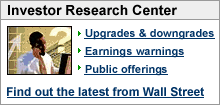|
Nasdaq 5,000: The way we were
Happy anniversary: Six years ago, the tech index hit an all-time high. Will it ever attempt it again?
NEW YORK (CNNMoney.com) - Happy anniversary, Nasdaq! What a special day Friday is. Six years ago, on March 10, 2000, the Nasdaq composite closed at an all-time high of 5,048.62. And it's never been anywhere near that again. Ever.
Certainly, the composite didn't head straight down after that, as markets don't move in straight lines. Even through the bear market of 2000-2002, there were mini rallies. But the Nasdaq never crossed 5,000 again. And some analysts say it never will. "The chances of the Nasdaq ever getting back there are very remote," said Donald Selkin, director of research at Joseph Stevens. "It would have to double itself, which would be like the Dow hitting 20,000, which is not going to happen." The Dow industrials currently stands at about 11,000. Ben Halliburton, chief investment officer and founder at Tradition Capital Management, says that while a return is dubious, 'never' is a long time to bet on. "It could be achieved someday," Halliburton said, "But the problem is you look at most of the Nasdaq companies, the biggest cap leaders, and you can argue that they are fairly valued where they are now," he said, as opposed to where they were trading back then. In other words, Amazon.com (Research) is perhaps more reasonably priced at the $36 per share it trades at now than the $105 it traded at in April 1999. JDS Uniphase (Research) is not likely to hit $138 per share again like it did in March 2000. Currently, JDS Uniphase trades at less than $4. What would it take?
During the 3-year bear market of 2000-2002, the Nasdaq lost an average of 30.6 percent per year on a compounded basis. But it has recovered at a slower rate. Although 2002 was ultimately a down year for stocks, many analysts consider the bear market to have bottomed out on Oct. 9, 2002, when the Nasdaq closed at 1,114.11. Between that Oct. 9 and Thursday's close, the Nasdaq gained around 1,120 points, or roughly 103 percent. Looking at just the three years of the bull market, 2003-2005, the Nasdaq gained a compounded average of 20 percent a year. Granted, the Nasdaq gained a huge 50 percent the first year of the bull market and has not gained much since. But let's say it really had gained 20 percent a year and like magic, could keep doing that in 2006 and beyond. It would be back above 5,000 by the end of the second quarter of 2010, more than 10 years after it last closed there. Halliburton said this scenario might take even longer. "Let's say the big Nasdaq stocks could grow earnings at 10 percent a year, which is more than the historic average of the S&P," he said. "You could argue that the Nasdaq could double itself in maybe the next seven to 10 years." Or roughly 2016, to get back to where we were in 2000. ---
For more market news, click here. |
|


